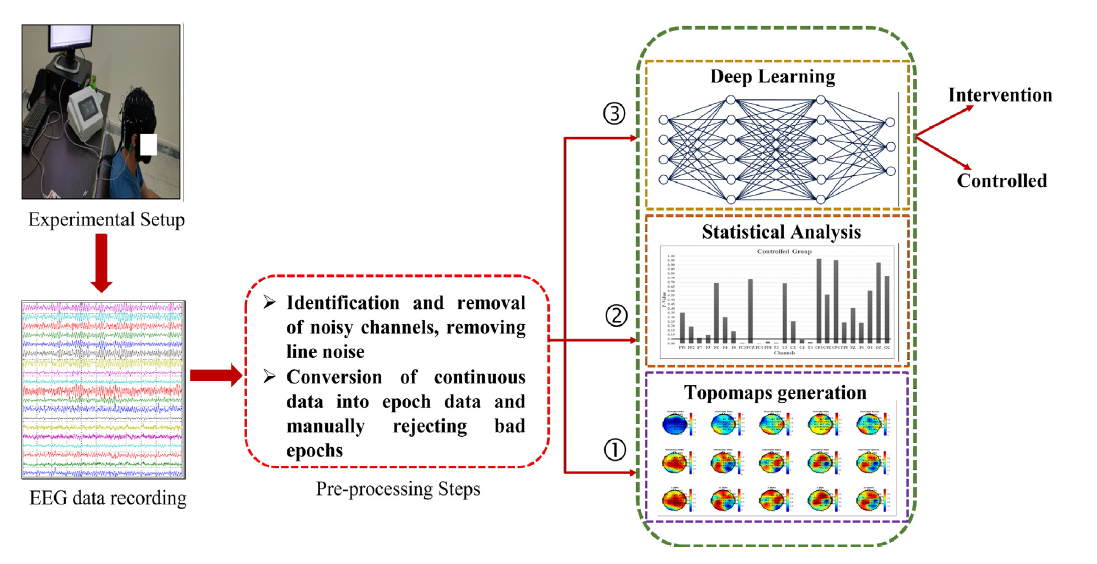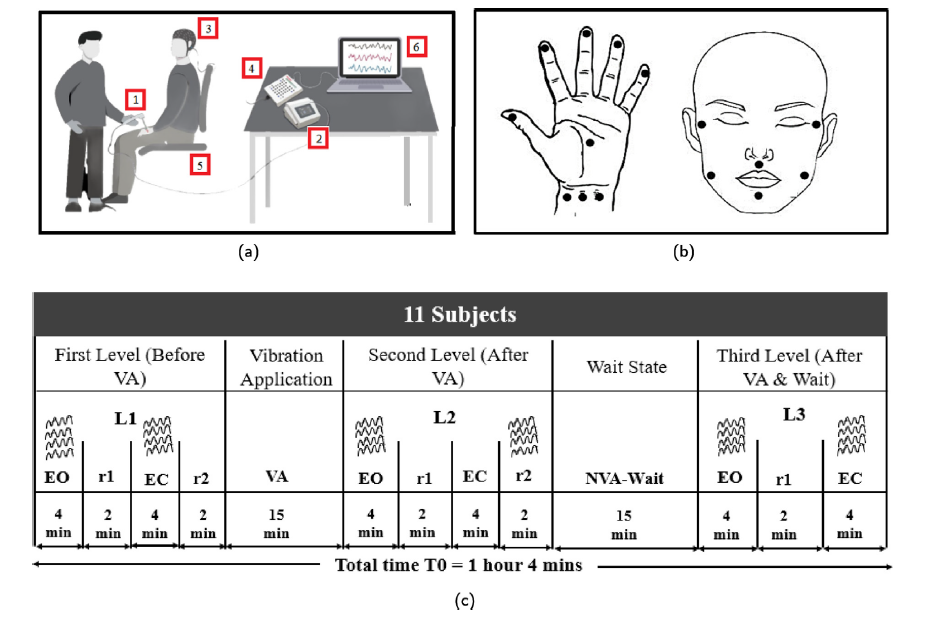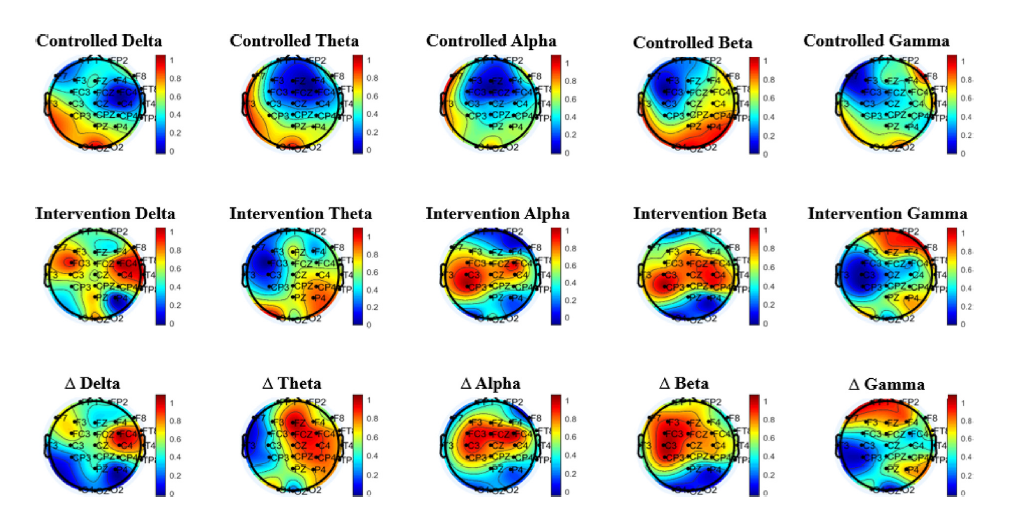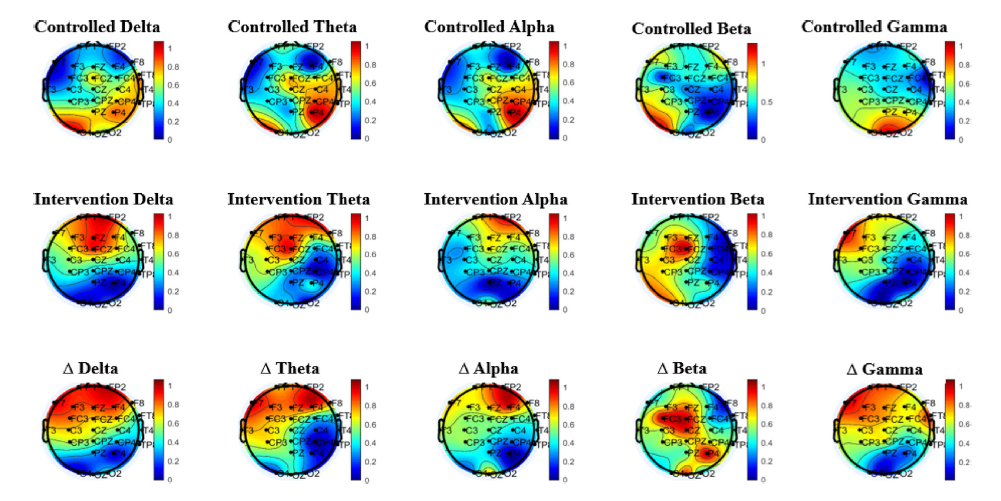EEG based Brain Study to highlight effects of vibration-based therapy on brain
Rehabilitation of patients with neurological disorders is a life-long process accomplished through pharmaco- logical and non-pharmacological procedures for patient management. One non-pharmacological treatment that has become increasingly popular in the last decade is brain stimulation using vibrations. This study analyzes the impact of vibrations on the brain utilizing electroencephalogram (EEG) signal analysis and visualizations to determine how they affect the brain. The participants were first treated with a controlled procedure by giving an illusion of vibrations, and then these subjects had an intervention phase during which vibrations were administered. EEG signals of the individuals were recorded in both phases during the pre-post therapy period using a 32-channel cap following a defined protocol. In contrast to the control group, topographical maps of five frequency bands of the intervention group showed activation in frontal theta and contra-lateral beta activities with further evidence provided by the outcomes of a paired sample t-test and Boxplots. The sensitivity of topo maps cannot reflect minor changes in the visualizations, although there is activity in the brain at that time. Therefore, the classification of EEG signals into controlled and intervention groups is perform to highlight the significance of those minor changes in EEG signals. This study proposed 3D Convolutional Neural Network (CNN) architecture with a combination of efficientnet-b4 for the classification of minor changes among these groups based on five frequency bands separately and combined clean data. The highest accuracy of 100% is achieved with combined clean data, beta, delta, theta, and gamma bands, while 98.34% for the alpha band.

Overall steps of proposed framework, including dataset curation, preprocessing, and three techniques (topo-maps, statistical analysis, and deep learning) for the validationof effects ultra-low frequency vibrations in controlled and intervention groups.

(a) Illustration for experimental Setup. 1: EKKO vibration head 2: EKKO hardware for controlling vibrations 3:EEG cap with electrodes covering head 4:Amplifier 5:comfortable chair for seating 6:System for recording EEG signals, (b) Nerve points to which therapy is applied: Five on fingers, one on middle of the hand, three on wrists, twoon cheeks, two on forehead, one below the nose and one on the chin. These nerve points are known points and taken from the field of acupuncture 40,74 Timeline and protocol of the experimental group. L1, L2 and L3 represents the three stages during which EEG was recorded. r1 and r2 represents rest states while VA and NVA-wait are the vibration application and no vibration application states during which EEG was not recorded. T0 is the overall time from L1 to L3 for a single subject.

Difference of controlled group and intervention group for randomly assigned subject. First row represents topomaps of controlled group, second row represents topomaps of intervention group and third row represents difference of first and second row.

Difference of controlled group and intervention group for all subjects i.e. average. First row represents topomaps of controlled group, second row represents topomaps of intervention group and third row represents difference of first and second row.

(a) p-values for controlled group. For all channels, p-values are greater then 0.05 (b) p-values for intervention group. For most of the channels, p-values are less then 0.05.
Relevant Publications
- Khan, Aliya Ashraf, Muhammad Usman Akram, Maryam Khalid, and Jahan Zeb. “The effect of vibration therapy on spasticity of children suffering from cerebral palsy: A systematic review.” In 2021 International Conference on Robotics and Automation in Industry (ICRAI), pp. 1-7. IEEE, 2021.
- Khan, Mohsin, Shahid A. Siddiqui, Mohd Akram, and Mohd Shadab Alam. “Can zinc supplementation widen the gap between control and complications in head and neck cancer patients treated with concurrent chemo-radiotherapy.” Journal of Medical Sciences 39, no. 6 (2019): 267-271.
- Khan, Aliya A., Shahbaz K. Ranjha, Muhammad U. Akram, Sajid G. Khawaja, and Arslan Shaukat. “Neurotransmission cognitive theory: A novel approach for non-invasive brain stimulation using mechanical vibrations for the rehabilitation of neurological patients.” Medical Hypotheses 143 (2020): 110078.